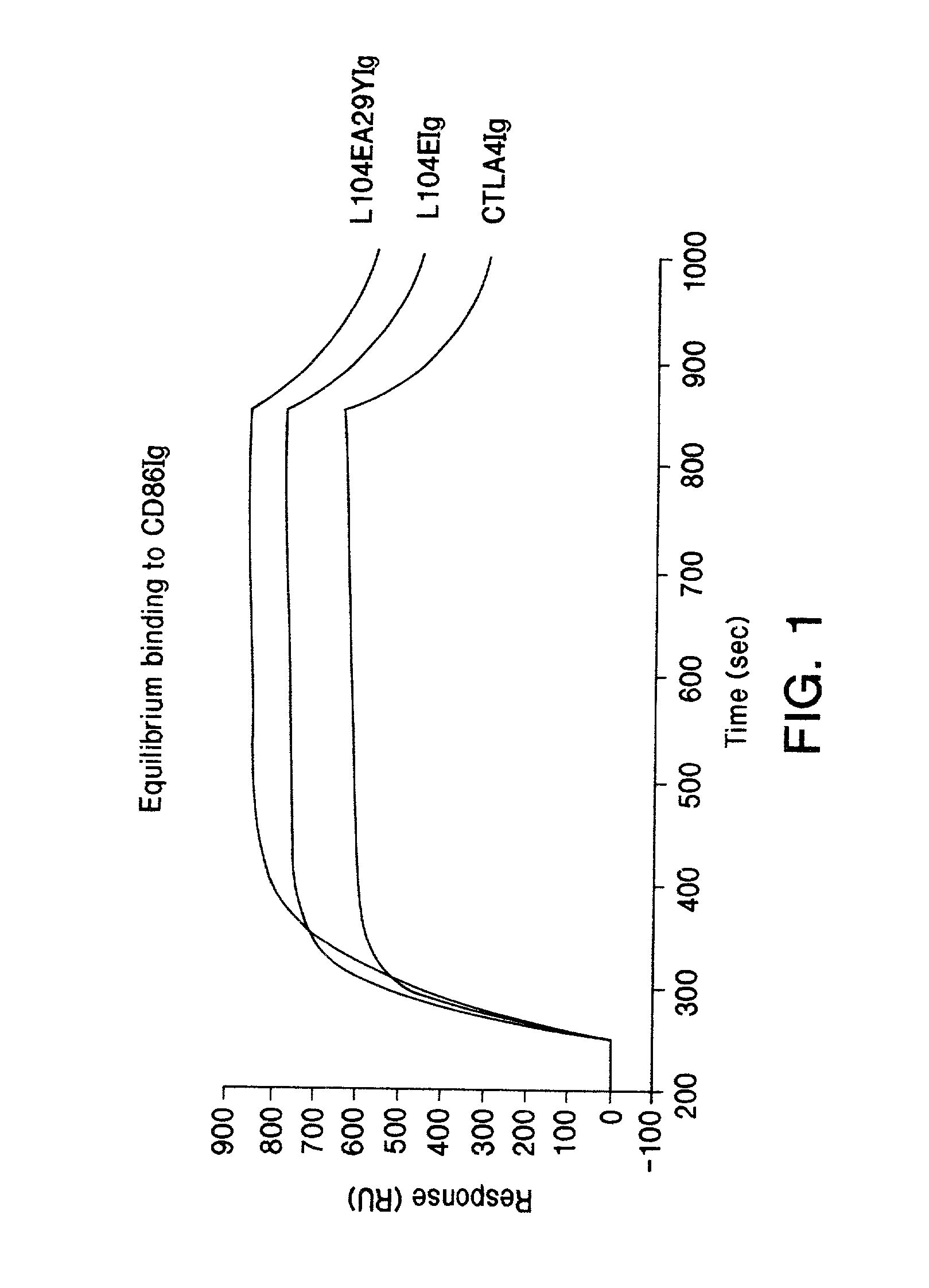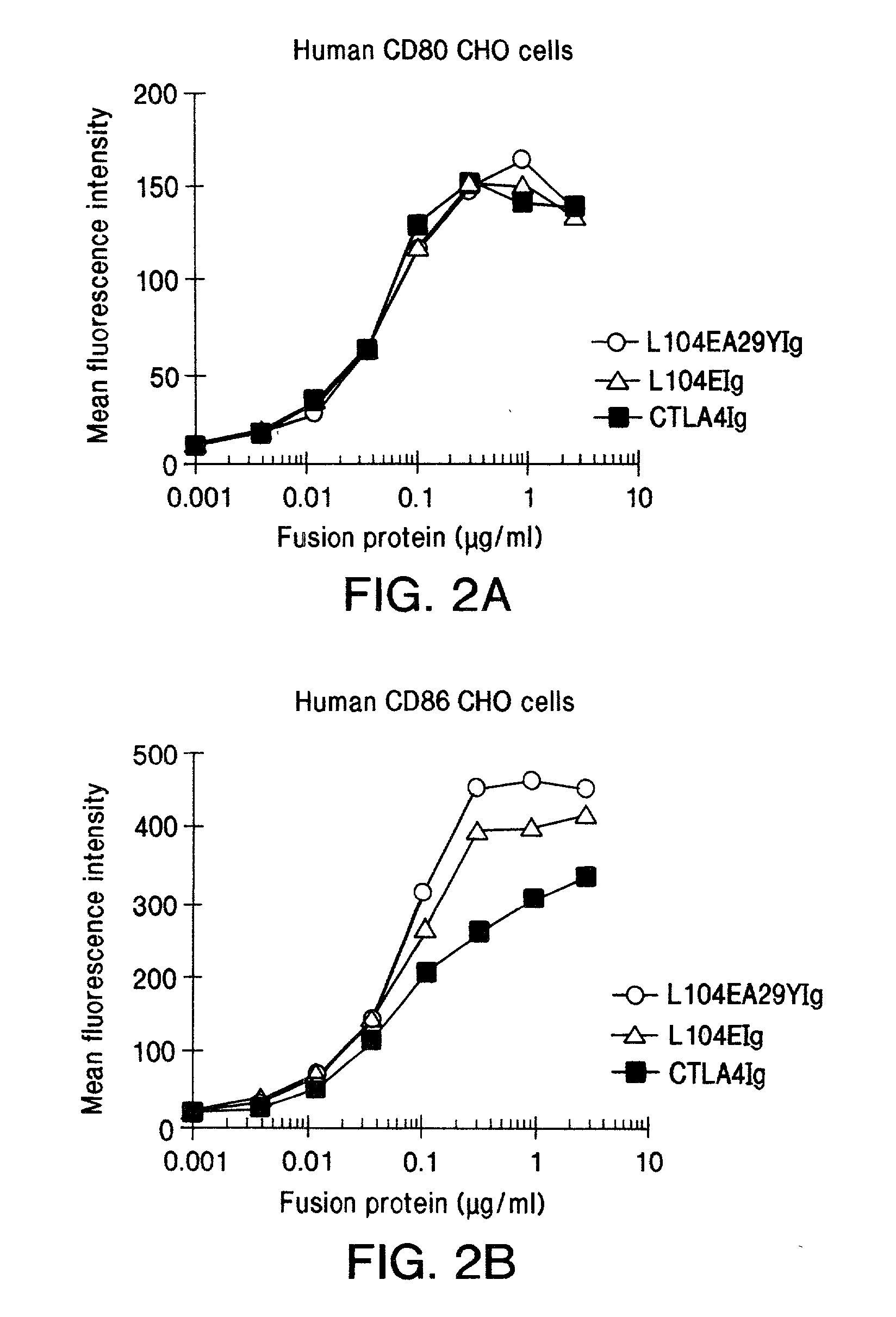Soluble CTLA4 mutant molecules
a ctla4ig, mutant technology, applied in the field of soluble ctla4 molecules, can solve the problems of not improving the binding avidity of cd80, but not being as effective at blocking the cd86-associated response, and achieves the effect of slowing down the dissociation rate of ctla4ig, rapid “on” rate, and rapid dissociation (“off”) ra
- Summary
- Abstract
- Description
- Claims
- Application Information
AI Technical Summary
Problems solved by technology
Method used
Image
Examples
example 1
[0112]This example provides a description of the methods used to generate the nucleotide sequences encoding the soluble CTLA4 mutant molecules of the invention. A single-site mutant L104EIg was generated and tested for binding kinetics for CD80 and / or CD86. The L104EIg nucleotide sequence was used as a template to generate the double-site mutant CTLA4 sequence, L104EA29YIg, which was tested for binding kinetics for CD80 and / or CD86.
CTLA4Ig Codon Based Mutagenesis
[0113]A mutagenesis and screening strategy was developed to identify mutant CTLA4Ig molecules that had slower rates of dissociation (“off” rates) from CD80 and / or CD86 molecules. Single-site mutant nucleotide sequences were generated using CTLA4Ig (U.S. Pat. Nos: 5,844,095; 5,851,795; and 5,885,796; ATCC Accession No. 68629) as a template. Mutagenic oligonucleotide PCR primers were designed for random mutagenesis of a specific cDNA codon by allowing any base at positions 1 and 2 of the codon, but only guanine or thymine at p...
example 2
[0115]The following provides a description of the screening methods used to identify the single- and double-site mutant CTLA4 polypeptides, expressed from the constructs described in Example 1, that exhibited a higher binding avidity for CD80 and CD86 antigens, compared to non-mutated CTLA4Ig molecules.
[0116]Current in vitro and in vivo studies indicate that CTLA4Ig by itself is unable to completely block the priming of antigen specific activated T cells. In vitro studies with CTLA4Ig and either monoclonal antibody specific for CD80 or CD86 measuring inhibition of T cell proliferation indicate that anti-CD80 monoclonal antibody did not augment CTLA4Ig inhibition. However, anti-CD86 monoclonal antibody did augment the inhibition, indicating that CTLA4Ig was not as effective at blocking CD86 interactions. These data support earlier findings by Linsley et al. (Immunity, (1994), 1:793–801) showing inhibition of CD80-mediated cellular responses required approximately 100 fold lower CTLA4...
PUM
| Property | Measurement | Unit |
|---|---|---|
| molecular mass | aaaaa | aaaaa |
| flow rate | aaaaa | aaaaa |
| affinity | aaaaa | aaaaa |
Abstract
Description
Claims
Application Information
 Login to View More
Login to View More - R&D
- Intellectual Property
- Life Sciences
- Materials
- Tech Scout
- Unparalleled Data Quality
- Higher Quality Content
- 60% Fewer Hallucinations
Browse by: Latest US Patents, China's latest patents, Technical Efficacy Thesaurus, Application Domain, Technology Topic, Popular Technical Reports.
© 2025 PatSnap. All rights reserved.Legal|Privacy policy|Modern Slavery Act Transparency Statement|Sitemap|About US| Contact US: help@patsnap.com



